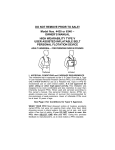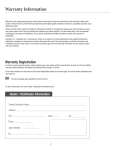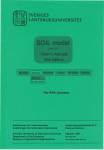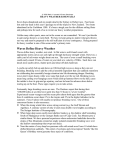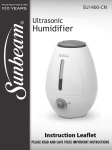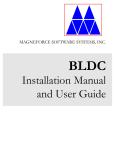Download DO NOT REMOVE PRIOR TO SALE! OWNER`S MANUAL
Transcript
DO NOT REMOVE PRIOR TO SALE! OWNER’S MANUAL Model 1439 Model 1443 & 33A43-H13 w/harness I. APPROVAL CONDITIONS and CARRIAGE REQUIREMENTS The above models are approved by the U.S. Coast Guard as Special Use Type V PFDs because the inflator on these products function in a manual or automatic mode. When armed to function in an automatic mode, these PFDs meet Type II PFD performance requirements since they will automatically inflate when submerged in the water. When armed in a manual only mode these PFDs meet Type III PFD performance requirements since you must pull the “Jerk to Inflate” tab to inflate the PFD. See Pages 9 and 10 for rearming instructions. The user must be aware of which mode the PFD is in. In addition, Model 1443 and 33A43-H13 are approved as a Special Use Type V PFD because it has an integrated harness that can cause injury (or death) if not used properly. See harness instructions on Pages 3 and 4. When fully inflated, both models will provide Type II in-water performance that will turn the wearer from a face down to a face up position and provide support suitable for offshore conditions. Inflatable PFD’s are not approved for water skiing or other high impact, high-speed activities. This inflatable was designed to be more comfortable and less restrictive to wear than inherently buoyant PFDs. When worn, used and serviced according to this owner’s manual, this PFD can greatly increase your chances of survival in the water. Not recommended for non-swimmers or weak swimmers. Users of inflatable PFDs must be at least 16 years old. MECHANISM PARTS LIST 2 SPECIFICATIONS Chest Size: 30 - 52 inches (76 - 132 cm) Weight Range: More than 90 pounds (40 kg) Minimum Height: For Harness Models ONLY - 5 feet 5 inches (165cm) Age Range: 16 years of age and older Buoyancy (minimum): 33.7 Pounds (150 Newtons) when fully inflated Inflation System: Manual/Automatic Inflation Mechanism (located on your right side) Oral Tube (located on your left side) Pull Tab (located on your right side) used to manually activate the inflation mechanism and inflate the PFD. CO2 Cylinder: 33 gram, with cylinder seal indicator. USE REARMING KIT #0924 Indicators: For the PFD to be fully armed, a cylinder must be inserted into the mechanism and the cylinder seal indicator must be Green. HARNESS USE INSTRUCTIONS FAILURE TO FOLLOW THESE INSTRUCTIONS COULD RESULT IN INJURY OR DEATH. • ALERT! Under no circumstances should the sailing harness be used in any climbing task or related activity. Failure to comply with this restriction in use may result in death or injury. • Always adjust harness snugly around your body. Failure to adjust properly may increase chance of injury. • Only use a tether that is less than 6.5 feet (2 meters) long. • This harness is not suitable for fall arrest. • Refer to page 7 for donning information. Always use both D-Rings for securing to a quick release under load tether (see illustration). 3 HARNESS FIT AND SIZING INFORMATION Sailing Harnesses are designed to be worn at the chest area to ensure the least injury potential, should the wearer be subject to sudden high shock loads. Fit - This harness is to be used by wearers 5 feet 5 inches (165 cm) and taller. This restriction is intended to locate the bottom of the harness belt at least 2 inches (5 cm) above the bottom of the rib cage or higher. Please verify that you can achieve this fit with the PFD adjusted comfortably snug. DO NOT USE AS A SAILING HARNESS IF THE HARNESS WEBBING DROPS BELOW THE RIB CAGE. Sizing - This PFD fits chest size range of 30 to 52 inches (76-132 cm), for wearers over 90 pounds (40 kg) and height restriction as stated above. ADDITIONAL HARNESS INFORMATION • This harness was designed and tested to meet the requirements for OFFSHORE RACING COUNCIL (ORC) requirements for Sailing Harnesses. • USCG approval does not apply to the sailing harness. • It is strongly recommended that first time users of Sailing Harnesses receive instruction from a reputable dealer, sailing school, or otherwise experienced harness sailor. • Always wear over all other clothing to allow for chamber expansion during inflation. • Harness that is attached to an anchored tether could over power flotation and take wearer down with the boat if not used with quick release under load hardware. II. MANDATORY CARRIAGE REQUIREMENTS Federal Regulations in 33 CFR 1756-1993 require you to carry Coast Guard approved personal flotation devices (PFDs) legibly marked with the Coast Guard approval number, which are in good and serviceable condition and are the correct size for each person on board. To be considered serviceable, this PFD shall not exhibit deterioration that could diminish its performance such as broken or deformed hardware, detached webbing, rotted structural components, air leaks or nonfunctional oral inflation tube. Unless worn inflated, this PFD must also be properly armed in either the “Manual Only” or “Automatic 4 Backup” mode. When armed in the “Manual Only” mode, the PFD will have a cylinder with a Green cylinder seal indicator installed in the mechanism, and a “Manual Only” tab installed in the pill drawer. When armed in the “Automatic Backup” mode, the PFD will have a cylinder with a Green cylinder seal indicator installed in the mechanism, and a pill cage assembly installed in the pill drawer. See Pages 9 and 10 for instructions. III. INSTRUCTIONS FOR USE PRE-DONNING INSTRUCTIONS CHECK THE FOLLOWING BEFORE EACH USE OR OUTING: 1. INSPECT PFD FOR DAMAGE 2. BE SURE A CYLINDER IS INSERTED INTO THE MECHANISM AND CYLINDER SEAL INDICATOR IS GREEN.” 3. CHECK TO BE SURE THERE IS A MANUAL OVERRIDE TAB STOWED IN THE ACCESSORY POCKET. A SPARE CO2 CYLINDER MAY ALSO BE PROVIDED. READ BELOW FOR MORE DETAILED INFORMATION! 1. Inspecting Your PFD For Damage Make sure that the PFD is free from rips, tears or punctures. This type of damage on the outside covering indicates that the Inflatable Chamber may have been exposed to potentially damaging elements. If these defects expose the yellow inflatable chamber material, discontinue use of the PFD until you have the PFD inspected by an authorized repair facility. If these defects are noticed but the yellow inflatable chamber material is not exposed, the Inflatable Chamber should be checked for leaks. The Inflatable Chamber should also be checked for leaks at the beginning of each season and at least every two months during the boating season. The leak test procedure is described under USER'S INSPECTION. (Refer to Pages 14 and 15.) 2. How to Inspect the Mechanism The mechanism is located on your right side under the protective cover. Before inspecting the mechanism remove the CO2 cylinder to prevent unnecessary discharge. 5 Be sure the cocking lever is in a locked position. The CO2 cylinder contains the gas charge that will inflate your PFD when the inflation mechanism is fired either automatically or manually. You must verify that the CO2 cylinder installed is of the correct size specification and has not been previously fired. Check the pill cage assembly to be sure that the pill is not cracked or otherwise damaged. To do this, first remove the CO2 cylinder, lift the cocking lever and remove the pill cage. If the pill in the pill cage assembly is cracked or damaged, replace with a new pill cage assembly, as shown in rearming instructions on Page 9 or 10. Be sure that a cylinder is inserted into the mechanism and that the cylinder seal indicator shows Green. If the indicator shows Red, replace with a new cylinder following the rearming instructions on Page 9 or 10. If a new pill cage assembly is not available, replace with the Manual Override Tab that is stowed in the accessory pocket. REMEMBER: Your PFD is now on a Manual Mode and will not inflate automatically and it is your responsibility to let any other users know this. Additional Notes on CO2 Cylinders: • FAILURE to properly rearm the inflation mechanism prior to installing the CO2 Cylinder will result in premature activation of the cylinder. • CO2 Cylinders are only good for one (1) inflation and cannot be recharged. • CO2 Cylinders are made with a protective coating that may wear off after a period of use or exposure to the environment. When this coating is worn off, the CO2 Cylinder may start to show some signs of rusting. If this occurs, replace the CO2 Cylinder. • If a gram scale (such as a postal scale) is available, it is recommended to weigh the cylinder to verify that it meets the minimum weight imprinted on the cylinder. 6 DONNING INSTRUCTIONS STEP 1 Wear like a jacket, inserting arms between straps and fabric. STEP 2 Close front buckle. Manual pull lanyard should be visible on your lower right side. STEP 3 Adjust belt through slide located on right side until a comfortably snug fit is obtained. For Harness Models be sure that the bottom of the harness belt is at least 2 inches (5 cm) above the lowest rib. Adjust belt keeper to reduce slack in webbing. After donning, locate the Jerk To Inflate tab for the mechanism. It should protrude from the PFD as shown on the pictogram. Make sure that you are comfortable locating the Jerk To Inflate tab with either hand. Should an emergency develop, be prepared to use it! Always wear your PFD over, not under clothing. Caution: bulky clothing may affect the ability of this PFD to turn the wearer to a face-up position in the water. Practice closing hardware and adjusting straps before use or prior to inwater testing. INFLATED DONNING INSTRUCTIONS Inflatable PFDs can be very difficult to don when fully inflated. Deflate through the Oral Tube until enough gas has escaped to don. See DEFLATION INSTRUCTIONS on Page 11. Don as described above and re-inflate orally as described on Page 8. 7 INFLATION INSTRUCTIONS See Pages 17-20 for additional information on testing and inflating your PFD. 1. Manual Inflation - To inflate, grasp the Jerk to Inflate tab and pull sharply downward. 2. Automatic Inflation - The automatic Inflation Mechanism will activate when the device is totally immersed in water. Depending upon temperature, the device will obtain full buoyancy within 5 to 10 seconds. It is recommended that the user regard the automatic system as a backup and always be prepared to pull the Jerk to Inflate tab upon immersion. 3. Oral Inflation - The Oral Tube is located on the wearer's left side. Grasp the Oral Tube and bring to mouth. Blow air through the Oral Tube until the Inflatable Chamber is firm. If the chamber becomes soft due to CO2 permeance, Oral Inflation will be necessary to maintain full buoyancy. Whenever you orally inflate the PFD it would be a good practice to remove the CO2 cylinder prior to inflating. If you plan on going into the water after oral inflation, also remove the pill cage so it may be reused when rearming the PFD. 4. Cold Inflation - Oral Inflation may be required in addition to manual or automatic inflation if chamber is not firm due to cold temperatures at or below 40° F (4° C). Inflation time using CO2 gas will be longer at these temperatures. Activation of automatic system may also be slower. Always be prepared to use the manual inflation system! See FREEZING TEMPERATURES on Page 13. 5. Other Inflation Precautions • Caution: Do not fully inflate orally then manually or automatically inflate with the CO2 cylinder. Repeated CO2 inflation after oral inflation will damage the PFD to the point that it will not hold air or float. • When armed in automatic mode, never orally inflate out of the water and then go into the water because the CO2 system will automatically inflate, which could damage the PFD. • Never inflate this PFD with a Pump or Air-Compressor. • Permeation loss is greater when the device is inflated with CO2 than with air, and earlier replenishment by means of the oral inflation system will be necessary after several hours. 8 9 10 DEFLATION INSTRUCTIONS Depress Oral Valve (located inside end of Oral Tube) using either the protective cap or tab provided by inserting into the end of Oral Tube, see drawing. Gently compress air out of the inflatable chamber while depressing the Oral Valve. DO NOT TWIST OR WRING INFLATABLE CHAMBER TO DEFLATE. If for any reason the Oral Valve remains open, depress it several times. If it does not release, discontinue use of this PFD and take it to a certified repair station. (See Page 16 for repair station locations/information.) In an emergency situation, hold thumb over the valve if it will not close, or fold the oral tube in half and squeeze together. Refer to page 12 for Repacking Instructions. 11 REPACKING INSTRUCTIONS Always deflate the PFD and rearm the Inflation Mechanism - follow REARMING Instructions prior to REPACKING! 1. Lay device out flat with the yellow inflatable chamber up. Fold right inside edge over as shown, exposing Velcro® strip. 2. Fold right outside edge over, securing Velcro® strips. Fold left inside edge over, exposing Velcro® strip. 3. Fold left outside edge over, securing Velcro® strips. Fold right topside over, exposing Velcro® strip. Position Jerk to Inflate Tab below bottom of clear window pocket. Fold left topside over, securing Velcro® strips. 4.Snap back strap to shell. Secure Velcro® strap extensions. Examine all straps, belt keepers, adjustment slides and buckles to assure that they are free from twists. Check to see that the Jerk to Inflate Tab is hanging free and the green indicator is clearly visible through the plastic window. 12 FREEZING TEMPERATURES Never use in below freezing temperatures, unless worn partially inflated. At or below 40° F (4° C) automatic activation and inflation time with CO2 gas will be longer. Wearing a partially inflated PFD in these conditions will provide some initial buoyancy while the PFD fully inflates. Caution: Do not fully inflate orally and then inflate with the CO2 cylinder. Repeated CO2 inflation after oral inflation will damage the PFD to the point that it will not hold air or float. OTHER USE GUIDELINES 1. Always wear your PFD when underway unless you are inside a cabin. 2. If you need to jump from any height always fold arms over your chest to keep the PFD in place when entering the water. 3. Avoid all unnecessary activities that will be abrasive to the device. 4. Use extreme caution around sharp objects. 5. Avoid unnecessary exposure to the sunlight. See GENERAL PRODUCT LIFE EXPECTANCY on Page 14. 6. CO2 gas from the cylinder will permeate through the chamber fabric over time. If you are in the water for a long time, it may be necessary to top off the inflatable orally, by blowing air in through the oral tube. 7. Inflatable PFDs are not designed for activities in which the wearer expects to encounter impact with the water at a high speed such as water skiing, riding personal watercraft, etc. 8. Inflatable PFDs are not designed for white water activities. 9. For Inflatable PFDs that have a manual-auto inflator, dropping the PFD into the water or exposing the inflation system to unnecessary water spray, will result in an inadvertent inflation. IV. IS YOUR PFD IN GOOD AND SERVICEABLE CONDITION? Check your PFD between outings to be sure that it is properly armed; that it is free of rips, tears or holes; that all seams are securely sewn; and that the fabric, straps and hardware are still strong. Inspect the inflatable portion of the PFD in accordance with Care and Maintenance Instructions. 13 V. CARE AND MAINTENANCE INSTRUCTIONS GENERAL PRODUCT LIFE EXPECTANCY The reliability and service life of this PFD depends greatly upon how it is used and cared for. Avoid storing PFD in direct sunlight. Sunlight contains ultraviolet radiation that weakens synthetic materials. Prolonged exposures to high temperatures and high humidity may shorten service life of this PFD. While it is known that these elements degrade the materials, every use environment is unique so there is no sure way to estimate how long the PFD will last. It is for this reason that you must follow the care and cleaning instructions and perform the maintenance and service checks. This will assure that the PFD remains functional and will maximize the useful life of this PFD. Failure to follow these instructions rigorously could result in a non-functioning PFD causing injury or death. USER'S INSPECTION The users should perform the following checks before each season, or before a long journey, or before each outing, as recommended below: 1. Physical Inspection of Cover and Straps - Examine outer shell fabric, seams, webbing attachments, buckles, slides, etc. Fabric fading can indicate a loss of strength. Check for strength by pulling seams and attachments snugly. If device shows any signs of damage, return to a certified Stearns Repair Facility or replace the entire device. This inspection should be performed each outing. 2. Oral Inflation Leak Test - This test should be performed every two months and at the start of each season. Inflate buoyancy chamber using the oral inflation valve and leave to rest for 16 hours. When buoyancy chamber remains firm and full of air, there is no leakage and chamber is operational. If the chamber deflates during this leak test, immediately bring to a certified Stearns Repair Facility for repair. The device is no longer in operational condition. 3. Automatic Inflation System - This test should be performed during years when the PFD is not inspected by a certified Stearns Repair Facility, and will expend your CO2 cylinder and pill. So make sure you have a rearm kit before conducting this test. With device packed as normal, immerse the device into a tub of water and see if it inflates. DRY, REARM and REPACK as shown on Pages 9, 10 and 12. 14 User's Inspection (Cont.) 4. Function Test of Oral Valve - With the PFD inflated, remove the dust protection cap, and test the valve by pushing it down using the tab provided on the cap (refer to Page 11). The valve should depress easily, and when released it should automatically return to the closed position and reseal. REARMING KIT(S) Use Rearming Kit No. 0924. See Rearming Instructions on Pages 9 and 10. CARE AND CLEANING INSTRUCTIONS Drying - If the device is wet, place on a coat hanger to allow thorough drying. Do not place in direct sunlight to dry. Do not use any heat source or place on radiator. Cleaning - Damp wipe only with mild detergent recommended for synthetic fabrics. Remove grease and oil immediately. After every use, and before rinsing, first remove CO2 cylinder and pill cage assembly and rinse well with fresh water. Read instructions provided on the device. • • • • • DO DO DO DO DO NOT NOT NOT NOT NOT MACHINE WASH MACHINE DRY DRY CLEAN USE SOLVENT BASED CLEANERS BLEACH 15 STORAGE • Store your pill cage (water sensing element) in a ventilated package, do not store in a sealed container. • Store in clean, cool, dry area. • Do not store pill cage assemblies in high humidity or high temperatures (over 100°F) for an extended time. • Do not store pill cage assemblies for more than 18 months before use. REPAIR If you have any question about the condition or integrity of this product call 1-800-STEARNS (1-800-783-2767). A damaged device must be repaired by certified Stearns Repair Facility or discarded. SERVICING Stearns strongly recommends that this device be inspected at least every 24 months by a certified Stearns Repair Facility or STEARNS Inc. Call 1-800-STEARNS (1-800-783-2767) for your nearest authorized Stearns Repair Facility. VI. WHY ARE PFDS REQUIRED SAFETY EQUIPMENT? Drownings are the leading cause of fatalities involving recreational boating. A PFD provides flotation to help keep your head above water, help you to stay face up in the water, and increase your chances for survival and rescue. Most adults only need an extra 7 to 12 pounds (31 to 53 Newtons) of flotation to keep their heads above water. The proper size PFD will properly support the weight of the wearer. Since this inflatable PFD does not have inherent buoyancy, it provides flotation only when inflated. Familiarize yourself with the use of this PFD so that you will know what to do in an emergency. 16 VII. HOW AND WHY TO TEST YOUR PFD? Inflate your PFD and try it out in the water to: • Make sure it floats you: - Comfortably (When worn properly) - Adequately for expected wave conditions (Body shapes/densities affect performance) • Make sure it works: - A flow of bubbles should not appear (See Section V on Pages 14 and 15 for leak tests) - It should inflate quick and easily • Learn how it works by: - Activating the CO2 inflation system - Rearming the CO2 inflation system - Using the Oral inflator tube The U.S. Coast Guard recommends that you purchase two automatic rearming kits; one to be used immediately in testing the automatic inflation system (see HOW DO YOU TEST YOUR PFD USING THE AUTOMATIC INFLATOR?) and the other to carry on board as a spare. Since you should replace the pill cage assembly each year, the U.S. Coast Guard recommends you test the automatic inflation system in-thewater at the beginning of each boating season. By doing this, you demonstrate that the automatic inflation system is still working properly and reduce the likelihood of premature inflation and its associated dangers. The only check of the manual inflation system (with CO2 cylinder with the green indicator tab removed, and with either the pill cage or the manual only tab installed) would be to determine that the lever arm and piercing shaft move freely when moving the lever (attached to the pull tab) several times down and up. 17 HOW DO YOU TEST YOUR PFD USING THE AUTOMATIC INFLATOR? 1. To test your inflatable PFD, you will need: • Your fully armed PFD, and • Rearming kit approved for your PFD. (This kit contains a CO2 cylinder and pill cage assembly that you will need to use following this test.) 2. Put on the PFD. 3. Get into shallow water, just deep enough that you can stand with your head above the surface. Once the automatic inflator is under water the PFD should automatically, fully inflate within 10 seconds. 4. See if the PFD will float you on your back or just slightly back of vertical. In a relaxed floating position, verify that your mouth is well above the water's surface. Note the effect of where you hold your legs on how you float. 5. Get out of the water and remove the PFD. Remove the used CO2 cylinder and the used pill cage assembly from the PFD inflator. Deflate the PFD using the oral inflator. 6. Let the PFD dry thoroughly. REARM and REPACK (refer to Pages 9, 10 and 12) the PFD in accordance with the manufacturer's instructions! 18 HOW DO YOU TEST YOUR PFD USING THE MANUAL INFLATOR? 1. To test your inflatable PFD, you will need: • Your fully armed PFD, with the manual override tab in place, and • Rearming kit approved for your PFD. (This kit contains a CO2 cylinder and pill cage assembly that you will need to use following this test.) 2. Put on the PFD. 3. Actuate the inflation system by jerking firmly downward on the pull tab. The PFD should fully inflate within 5 seconds. 4. Get into shallow water, just deep enough that you can stand with your head above the surface. 5. See if the PFD will float you on your back or just slightly back of vertical. In a relaxed floating position, verify that your mouth is well above the water's surface. Note the effect of where you hold your legs on how you float. 6. Get out of the water and remove the PFD. Remove the used CO2 from the PFD inflator. Completely deflate the PFD using the oral inflator. 7. Let the PFD dry thoroughly. REARM in a manual only or automatic mode and REPACK the PFD in accordance with the manufacturer's instructions (refer to Pages 9, 10 and 12)! 19 HOW DO YOU TEST YOUR PFD USING THE ORAL INFLATOR? 1. To test your inflatable PFD, you will not need any spare parts or rearming kits. 2. Remove the CO2 cylinder and pill cage (if installed) assembly, to prevent inadvertent activation of the automatic inflation system, which could potentially damage the PFD. If the PFD was armed in the manual only mode, the "Manual Only" tab does not have to be removed. 3. Put on the PFD. 4. Get into shallow water, just deep enough that you can stand with your head above the surface. 5. If you are a weak swimmer or non-swimmer, inflate the PFD partially so that you are supported well enough to be able to complete inflation without touching bottom, either orally or manually. Note this level of inflation because it is the minimum needed for you to safely use this inflatable PFD. 6. Fully inflate the PFD using the oral inflator. 7. See if the PFD will float you on your back or just slightly back of vertical. In a relaxed floating position, verify that your mouth is well above the water's surface. Note the effect of where you hold your legs on how you float. 8. Get out of the water and remove the PFD. Completely deflate the PFD using the oral inflator. 9. Let the PFD dry thoroughly. REARM and REPACK the PFD in accordance with the manufacturer's instructions! Refer to Pages 9, 10 and 12. 20 VIII. WEAR YOUR PFD In approximately 80 percent of all boating fatalities, the victims were not wearing a PFD. Most fatal accidents happen on calm sunny days. This inflatable PFD is much more comfortable to wear than other PFD types. Get into the habit of wearing this PFD. Non-swimmers and children especially should wear a hybrid or non-inflatable PFD at all times when on or near the water. IX. HYPOTHERMIA Prolonged exposure to cold water causes a condition known as hypothermia - a substantial loss of body heat, which leads to exhaustion and unconsciousness. Most drowning victims first suffer from hypothermia. The following chart shows the effects of hypothermia: PFDs can increase survival time because they allow you to float without using energy treading water and because of their insulating properties. Naturally, the warmer the water, the less insulation you will require. When operating in cold waters [below 60°F (15.6°C)] you should consider using a coat or jacket style PFD or a Type V Thermal Protective PFD as they cover more of the body than the vest or belt style PFDs. 21 Some Points to Remember About Hypothermia Protection: 1. Always wear your PFD. Even if you become incapacitated due to hypothermia, the PFD will keep you afloat and greatly improve your chances of rescue. 2. Do not attempt to swim unless it is to reach a nearby craft, fellow survivor, or a floating object on which you can lean or climb. Swimming increases the rate of body heat loss. In cold water, drownproofing methods that require putting your head in the water are not recommended. Keep your head out of the water. This will greatly lessen heat loss and increase your survival time. 3. Use the standard H.E.L.P. position when wearing an inflatable PFD. Wrap your arms around your torso, under the PFD, and draw your legs up to a seated position. Doing so will help you conserve body heat. 4. Keep a positive attitude about your survival and rescue. This will improve your chances of extending your survival time until rescued. Your willto-live does make a difference! 5. If there is more than one person in the water, huddling is recommended while waiting to be rescued. This action tends to reduce the rate of heat loss and thus increase the survival time. 22 X. EACH OF THESE DEVICES IS INTENDED TO HELP YOU SAVE YOUR OWN LIFE For your PFD to function properly follow these suggestions to verify that it fits, floats, and remains in good condition. 1. Check the status of the inflator and make sure that the status indicator is green. Check before each outing. 2. Get in the habit of rearming the inflation mechanism right after each CO2 inflation. 3. This PFD requires rearming with a new cylinder, and pill cage assembly after each CO2 inflation. Always have rearming kits to service your inflatable PFDs. 4. Try your wearable PFD on and adjust it until it fits comfortably in and out of the water. 5. Mark your PFD with your name if you are the only wearer. 6. Do not alter your PFD. If it doesn't fit properly, get one that does. An altered device is no longer Coast Guard approved. 7. Your PFD is not intended for use as a fender or kneeling pad. 8. If your PFD is wet, allow it to dry thoroughly before storing it. Store it in a well-ventilated area. 9. Do not dry your PFD in front of a radiator or other source of direct heat. XI. ADDITIONAL INFORMATION If you need more information about PFDs and safe recreational boating, contact your state boating authority, U.S. Coast Guard Auxiliary, U.S. Power Squadron, Red Cross, or your nearest unit of the U.S. Coast Guard; or call the Coast Guard Customer Information Line at 1-800-368-5647 or the Free Boating Course number 1-800-336-BOAT (in VA, 1-800-245-BOAT) or see the USCG Boating Web Page at www.uscgboating.org. 23 DO NOT ATTACH PFD'S TO YOUR BOAT Each PFD has straps, hooks, buckles, or other means for securing the device in place on the wearer. Some PFDs also incorporate decorative dee rings or tabs. Such items are not to be used to attach the device to the boat. Attaching the device to the boat will not permit it to perform as intended. The exception is when a Safety Harness (Harness Models stated on Front Cover) are worn with a tether of less than than 6.5 feet (2 m) having a quick release under load hardware. Refer to Page 3 for harness use instructions. CO2 PERMEATION LOSS CO2 gas will permeate the chamber fabric over time. Oral Inflation may be necessary to maintain full buoyancy. BUDDY LINE INFORMATION Buddy lines, when provided, are to be used by people adrift in the water, to attach themselves to one another and aid in staying together. Buddy lines are not designed for lifting. IF YOU HAVE ANY QUESTIONS ABOUT THE INITIAL ARMING, REARMING, REPACKING, OR NEAREST AUTHORIZED STEARNS REPAIR FACILITY CALL 1-800-STEARNS (1-800-783-2767). PRODUCT REGISTRATION: PLEASE MAIL REGISTRATION CARD OR CALL 1-800-STEARNS (1-800-783-2767) IN ORDER TO RECEIVE IMPORTANT UPDATES ON THIS PFD.




























